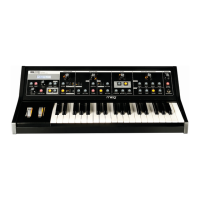Page 38
LP User’s Manual - Appendices
Page 39
LP User’s Manual - Appendices
So there you have it - the six basic components that make up a synthesizer based on the subtractive synthe-
sis model. Keep in mind that most ‘subtractive’ synthesizers often include more than one of each component.
This is especially true of the oscillators and envelope generators (the Little Phatty has two of each), but may
also be true of lters, ampliers and LFO’s. For example, the Moog Voyager has three oscillators, two lters,
two ampliers, an LFO, two extensive modulation sections, and the Voyager’s third oscillator can act as an
additional LFO. Synthesizers that offer more than one of each type of component provide a broader palette
for sound creation, resulting in sounds with a greater complexity, variation, and depth. Nonetheless even a
simple analog synth like the LP can be used for incredibly expressive sounds given solid programming and
playing technique.
So what is the best way to congure and program these synthesis components effectively? The answer could
ll a book’s worth of explanations and examples. Two such books on this subject are:
“Power Tools for Synthesizer Programming” by Jim Aiken, available from Backbeat Books
“Analog Synthesis” by Reinhard Smitz, available from Wizoo Publications
You can also learn a lot from examining the factory presets in detail. The Little Phatty’s presets were crafted
by some of the best sound designers in music today, and you can learn their secrets simply by exploring the
individual parameters that makeup the sound. Just dial up a few presets and dig in!
As with all musical instruments, practice, exploration and experimentation are an important part of achiev-
ing great results. Spend a little time getting to know your new instrument - your efforts will be rewarded!

